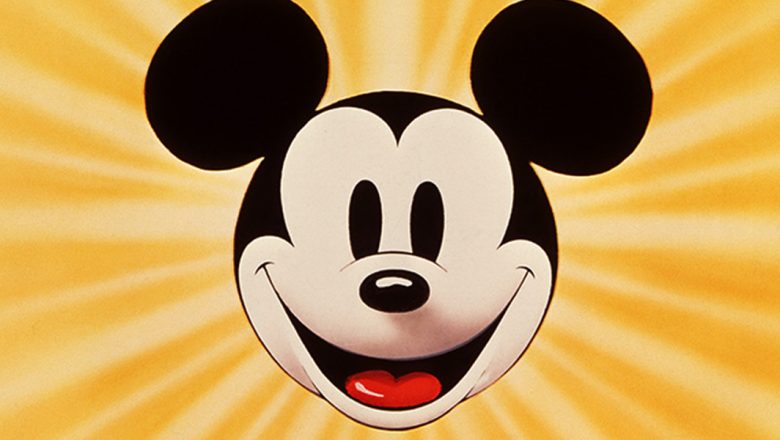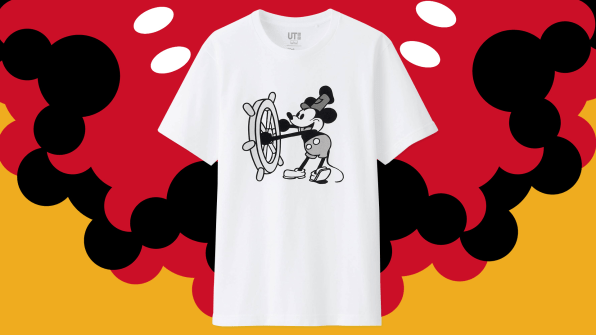
In March of this year, Gucci began selling a $4,500 purse in the shape of Mickey Mouse’s head. Between the creature’s round black ears is a small handle embossed with the word “Gucci.” On the brand’s website, a male model stares intensely into the camera without the slightest trace of irony that he is, in fact, toting around the disembodied head of a children’s cartoon character.
It’s perhaps the most luxurious of the recent Mickey Mouse products designed for adults, but it’s just one of many that has flooded the market. Over the past few months, Opening Ceremony released a line of ethereal dresses and activewear featuring vintage Mickey Mouse prints. High-end milliner Gigi Burris created a $450 crystal-beaded fascinator featuring Mickey’s ears. L’Oréal and Maybelline created makeup sets with packaging covered in Mickey’s face. Kate Spade released a $198 tote featuring a Mickey comic strip. Uniqlo made dozens of graphic tees with Mickey in various poses. And not to miss out on the action, Apple launched $300 Beats headphones that paid homage to the Mouse.

Part of this recent glut of Mickey products has to do with the fact that the character turned 90 years old last year. The Walt Disney Company, along with the many other brands that license Disney characters, sees anniversaries as an opportunity to sell even more Mickey paraphernalia than usual. According to the Wall Street Journal, Mickey Mouse and his gang (including Minnie, Goofy, Pluto, and Donald Duck) sold $3 billion in merchandise in 2018, a figure that includes both adult and children’s products. Shockingly, that is only about half of what Mickey made in 2004, when Disney heavily pushed out products in celebration of his 75th birthday.
All of this prompts the question: Why would adults wear items splashed with the face of a smiling rodent in the first place? What accounts for the enduring appeal of this anthropomorphized mouse, while other popular characters, like Ariel from The Little Mermaid, or Anna from Frozen, hardly ever appear in adult products?
The answer to the question has everything to do with the fact that Disney carefully orchestrated Mickey Mouse’s transformation from a cartoon character to a symbol. Disney ensured that Mickey could morph into almost anything the consumer needed him to be, from an emblem of hope in wartimes to a happy reminder of childhood when adulthood became overwhelming.

Mickey: Disney’s Best Salesman
Mickey Mouse was big business almost as soon as he made his debut in Walt Disney’s animated short Steamboat Willie in 1928. Within five years, Mickey was raking in $1 million a year in merchandise sales (equivalent to $19 million in 2019 dollars). Garry Apgar, a Yale-educated art historian who has devoted years to studying cultural representations of Mickey Mouse, tells me that in the early years, these products were largely targeted at children, and included stuffed toys, trains, and nursery wallpaper.
Everything changed in the years after World War II, Apgar says. At that point, demand for products bearing Mickey’s face among adults spiked. For one thing, Mickey was nearly two decades old, which meant that the first audience that enjoyed the cartoons as children were now in their 30s and 40s. But Disney was also willing to transform Mickey into a symbol of innocence, and Americanness during the war and in the postwar years, when people were desperate for something hopeful to cling to.
All the marketing worked. A 1947 New York Times article explained that products featuring Disney characters generated $100 million in revenue in merchandise for children and adults. At the time, Disney had already created Snow White, Pinocchio, Dumbo, and Bambi, but “Mickey is the best salesman of the lot,” the Times’ reporter wrote. In addition to kids’ products, like dolls and cereal boxes, many of the items sold were for adults, including radios, phonographs, and hot-water bottles. A total of 600,000 Mickey Mouse watches, which came in both kid and adult sizes, were sold that year alone.
By 2004, Mickey had made it to Forbes annual list of “fictional billionaires,” which identifies the bankability of characters from novels, movies, TV, and games. (Others on the list that year included Frodo Baggins, from The Lord of the Rings, and Spiderman.) “It’s not just kids who love Mickey,” the article read, pointing out that the mouse’s impressive earnings in recent years had been driven in part by a surge in adult apparel. In the words of Kay Kamen, Walt Disney’s very first licensing agent, who spoke to the Times in 1947: “No doubt of it. Mickey Mouse is the greatest thing in the history of merchandising.”

You Can’t Look Away From The Mouse
It’s no accident that adults like Mickey Mouse: Walt Disney made sure that it was nearly impossible not to.
Over the course of Mickey Mouse’s first two decades, Disney kept tweaking the character to make him more and more universally appealing. He made Mickey’s face and body rounder and more childlike. Mickey’s eyes became larger and rounder, like those of a baby. This is something that the Harvard evolutionary biologist Stephen Jay Gould observed and described as “neoteny,” which refers to the retention of juvenile features in adult animals.
Why was this effective at getting adults’ attention? Scientists have shown that adults are more drawn